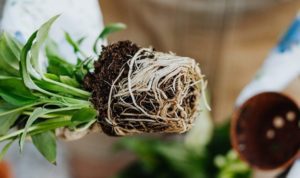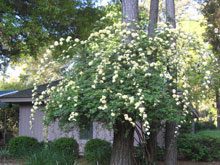 Garden columnist Alice Massey wrote a column with this title, and I liked it so much that I pinched it for this one.
Garden columnist Alice Massey wrote a column with this title, and I liked it so much that I pinched it for this one.
Like she wrote, this isn’t about touch-ups at the beauty shop, it’s about plant roots.
Roots don’t have a ‘squeaky wheel’ to indicate when they need attention, but they are the undoubtedly the most important part of any plant. They are the vector for life-giving water, oxygen and nutrients.
One of the things I encounter most often on my Rent-a-Master Gardener visits* is an issue with roots. Homeowners (and landscapers, too), tend to plant trees and shrubs too deeply, and equally bad, pile mulch up against the trunk. Mulch against the trunk will tend to keep that area damp, and encourage disease and insect damage. Always, always keep a mulch free circle at least 10” away from the trunk.
Properly planted trees will have a visible flare at their base. This is where the root system begins and it needs to be exposed. Even trees that have been properly planted can, over time, accumulate a build-up of leaves and garden detritus around the base which will bury the root flare.
While shrubs don’t have an actual root flare, they, too, can be planted too deeply or smothered with leaves and mulch.
When you remove the soil, mulch or detritus at the base of shrubs or trees (we always strongly recommend this) to expose the root flare, use caution not to damage the roots themselves. Rather than dig around roots too deeply all at once, it’s better to do this in stages.
The roots of many trees go all the way out to the drip line or farther, making it hard to plant anything under the tree. However, if you start out with small plants, their slow root expansion will gradually make their way around the existing tree roots without damage to either. But make no mistake. In the competition for nutrients and water, the tree will always win, so you’ll need to add supplemental feeding and irrigation for those understory plants.
Although every tree starts with a tap root to provide stability, as it matures, other roots outgrow the taproot. A tap root will stop growing when it hits soil that lacks the oxygen and nutrients it needs to survive. I wish I had an indicator to stop me growing . . . sideways, that is.
When deciding on a site for a tree, you need not only to keep in mind the safety of your home’s foundation from root intrusion, when a tree is planted in or nearby an irrigated lawn, its roots will always migrate into the lawn to get at the easy water and make the turf hard to walk on and almost impossible to mow.
I made the mistake of planting a tulip tree and a magnolia sapling too close to my house. They only cost $10.00 each, but 10 years later, they cost $1,000.00 each to remove.
When planting a potted tree, but sure to check the roots. If the plant is root bound, you can make several vertical slices around the root ball before planting. Some experts even advise that you wash off what little soil there is, and gently ‘comb’ out the roots before planting. It’s important to address root problems when you plant, especially if you see that roots have begun to circle around the root ball. If they are, you’ll need to pull them out of the circle, and slice where necessary so that you interrupt their circular path. If you neglect to do this and just plunk them into the hole, they will continue their circular growth and the tree will never reach its potential growth and may even succumb by strangulation. Now that’s real murder.
Too, the tree may have been re-planted several times by the grower into larger pots as they grew, and new soil just put on top of the root ball. This means that the root flare will already be covered when you buy it. You’ll need to gently remove that soil until the root flare is exposed before you plant it into your garden.
The most recent advice from those who are supposed to know (and Clemson, too) is NOT to amend the backfill soil when planting trees. The rationale is that the roots will stay in the amended soil and not migrate out of the original hole which was dug. Well, this might be true and good advice for other areas, but I sure take issue with it down here in the Lowcountry.
Our natural soil is mostly lean dirt and sand so just plunking it in a hole and leaving it to fend for itself is not going to give it a very good start. If you plant a tree properly, you will have made a very large hole (width; not depth) and not only will the amended soil in that hole sustain the tree’s growth until it’s very well established, it will encourage a healthy and vigorous root system. I’ve spoken to several knowledgeable landscapers (Jay Weidner, being one) who agree. So unless you move to Pawtucket, you need to amend your soil.
Which just proves that successful gardening in the Lowcountry doesn’t always follow established horticultural rules.
*https://lowcountrymga.org/lowcountry-master-gardener-association-rent-a-master-gardener/









